Hyperledger Fabric
Hyperledger Fabric, or Fabric for short, is the contribution made initially by IBM and Digital Assets to the Hyperledger project. This contribution aims to enable a modular, open, and flexible approach toward building blockchain networks.
Various functions in the fabric are pluggable, and it also allows the use of any language to develop smart contracts. This functionality is possible because it is based on container technology (Docker), which can host any language.
Chaincode is sandboxed in a secure container, which includes a secure operating system, the chaincode language, runtime environment, and SDKs for Go, Java, and Node.js. Other languages can be supported too in the future, if required, but this needs some development work. This ability is a compelling feature compared to domain-specific languages in Ethereum, or the limited scripted language in Bitcoin. It is a permissioned network that aims to address issues such as scalability, privacy,...



